A tilt garage door is an overhead garage door that operates by lifting vertically before tilting inwards on horizontal tracks along the garage ceiling.
Unlike sectional overhead garage doors that fold up in sections, tilt garage doors are a single rigid panel that lifts and tilts as one piece.
Tilt garage doors provide full access to the garage opening and allow vehicles to park very close to the door while still allowing it to operate thoroughly.
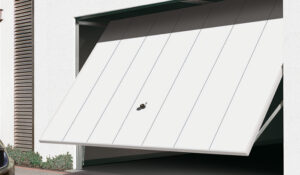

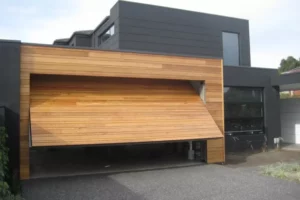
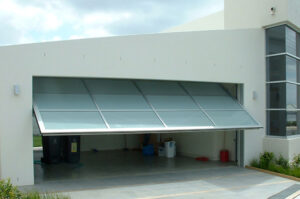
How Tilt Garage Doors Work
Tilt garage doors operate differently than traditional sectional overhead doors. Instead of folding up in horizontal sections, they are constructed as a single rigid panel.
A tilt garage door is lifted vertically on tracks along the garage walls by torsion or extension springs to open. Once it reaches the fully open position, the bottom edge of the door panel detaches from the vertical tracks.
The top edge of the door remains secured to horizontal tracks mounted along the ceiling. These ceiling tracks then guide the door panel to tilt inwards into the garage interior.
The single-panel construction allows the tilt garage door to open fully without folding into itself like a sectional door.
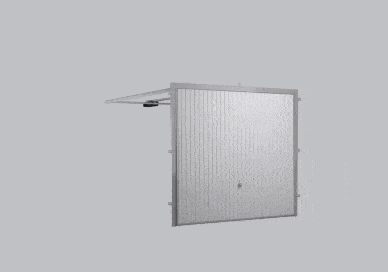
Once tilted fully inwards into the garage, the tilt door provides complete access to the opening. The horizontal ceiling tracks hold the door panel in place so vehicles can park close to the opening without obstructing operation.
To close, the process is reversed. The single panel is tilted outwards from the ceiling and lowered down the vertical tracks on the walls. The panel remains perpendicular to the floor while being lowered.
Once fully lowered, the bottom edge reconnects with the vertical tracks, sealing the garage opening.
Benefits of Tilt Garage Doors
Some of the main benefits of tilt garage doors are mentioned below.
- Full access to garage opening – Unlike sectional doors that fold up, tilt doors provide complete access to the garage when open since there are no tracks along the floor. This allows for more accessible parking and maneuvering of vehicles.
- Space-saving design – Tilt doors open vertically before tilting inwards, requiring less interior ceiling space than sectional doors. The tilt mechanism allows vehicles to park very close to the door while it opens.
- Aesthetic options – Tilt doors come in a wide range of materials like wood, aluminium, glass, etc. Windows, hardware, and decorative finishes are available for an attractive look.
- Durability – Made of a rigid single panel, tilt doors are generally durable and resilient against impact. Their solid construction provides good insulation, too.
- Smooth operation – The tracks guide the door through a smooth tilting motion that requires little effort, especially with automation.
- Increased clearance – As the door panel lifts directly upwards, tilt doors provide greater clearance for taller vehicles than sectional doors.
- Security – With a continuous panel, tilt doors do not have seams that intruders could pry open. Deadbolts and auto-locking provide security.
- Garage lighting – Windows and glass panel designs allow daylight into the garage interior when the door is closed.
Consideration Before Choosing Tilt Garage Door
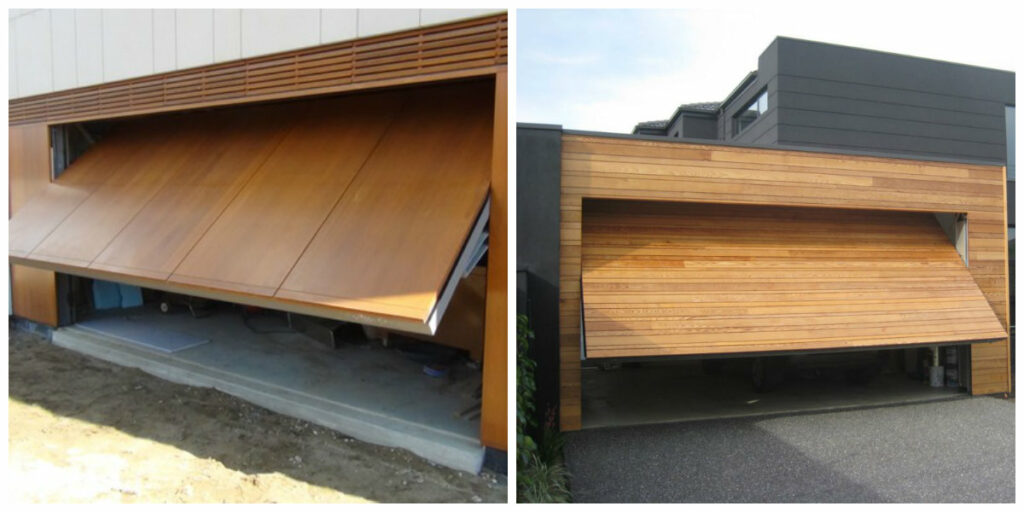
Some key considerations when comparing tilt garage doors to sectional (panel) and roller doors are mentioned below.
- Cost – Tilt doors are generally more expensive than sectional and roller doors. The tilting mechanism and single-panel construction are more complex.
- Space requirements – Tilt doors require significantly more headroom clearance to allow space for the horizontal ceiling tracks. At least 10 inches is needed. Sectional doors need headroom equal to the door height.
- Strength – The solid single panel of tilt doors makes them heavier and harder to operate than sectional or roller doors manually. Though they are very durable.
- Mechanics – Tilt doors have more moving parts with the tilting mechanism. This makes them harder to repair than other types if something breaks.
- Aesthetics – Tilt doors provide a more seamless look and offer more decorative styles than sectional doors. Roller doors have a more industrial look.
- Insulation – The rigid panel of tilt doors offers better insulation and weather sealing than the sectioned panels of sectional doors.
- Automation – Tilt doors are harder to automate than sectional and roller doors, which have simpler vertical movements. But automated tilt doors are available.
- Wind resistance – The large single panel of tilt doors makes them more prone to wind damage than sectional doors. Reinforcement is needed.
- Garage ceiling – Tilt doors require high and open garage ceilings to allow room for the horizontal tracks. Sectional and roller doors need vertical tracks.
Tilt Garage Door Materials
Wood
Wood tilt doors provide a classic, aesthetically pleasing look. Types of wood used include cedar, redwood, meranti, hemlock, and pine. Wood is lightweight and naturally insulating. However, it requires regular maintenance, such as repainting or restaining to prevent damage from moisture and pests. Overall, wood is an attractive but high-maintenance option.
Steel
Steel is one of the most robust and durable options for tilt doors. Steel panels resist dents and damage while providing security against forced entry. Galvanised and stainless steel offer corrosion resistance. Steel conducts heat well, though, so insulation is essential if climate control is desired in the garage. Steel doors require relatively low maintenance.
Aluminum
Aluminum offers the resilience of steel with increased corrosion resistance. It is lightweight for easy operation and reflects heat to prevent energy loss better than darker steel. However, uninsulated aluminium panels can still conduct heat, so insulation should be added. Aluminium requires low maintenance and has a contemporary look.
Fiberglass
Fiberglass tilt doors are impact-resistant and provide excellent insulation. The highly resilient material prevents dents and dings from occurring in the panels. Fiberglass doors have a similar appearance to wood but require less maintenance. Vinyl cladding can be added for further durability. Overall, fibreglass is a solid and energy-efficient choice.
Vinyl
Vinyl is a lightweight synthetic tilt door material. It resists corrosion and provides sound insulation. Vinyl doors mimic the look of wood grain while requiring less maintenance. However, when exposed to extreme temperatures, vinyl can become brittle and crack over time. It lacks the strength of steel and fibreglass.
Where Are Tilt Garage Doors Commonly Used?
Here is where tilt garage doors are commonly used:
- Home garages with high ceilings – The extra vertical space allows overhead horizontal tracks. At least 10 inches of headroom is needed.
- Commercial and industrial facilities – The overhead access benefits machinery, vehicles, and cargo. Durability aids heavy use.
- RVs and ample vehicle storage – The unobstructed access helps accommodate tall vehicles like RVs, buses, and trucks.
- Barns and agricultural buildings – Tilt doors allow equipment ingress/egress while resisting weather and corrosion.
- Aeroplane hangars – Tilt doors maximise clearance for aircraft tails and wings entering the hangar space.
- Boat houses – Tilt doors provide wide entry when opening for boats and other watercraft.
- Warehouses and self-storage – Accessibility for loading/unloading and high-traffic ingress/egress are aided by tilt doors.
Risks and Precautions with Tilt Garage Doors
Tilt garage doors provide unique benefits over other overhead garage door types but also come with essential considerations to keep in mind.
When evaluating if a tilt garage door is right for your home or facility, it is helpful to understand both the advantages of these doors as well as the potential drawbacks.
Some significant points to consider are mentioned below.
- Pinch points – Tilt doors have more moving parts to create pinch points along the tracks and hinges during operation. Keep hands and objects clear when operating.
- Heavy door – The weight of the rigid single panel makes tilt doors heavier than sectional doors. Attempting to raise it manually without aids can lead to injury. Use mechanical assists.
- Wind damage – The large surface area can catch heavy winds, putting strain on brackets. Reinforce mounting if in high wind regions.
- Track alignment – Improperly aligned tracks cause the door to bind, jam, or fall. Ensure professional installation and maintenance.
- No backup breakage – The heavy door can rapidly fall when springs or cables fail since there is no segmented backup. Have safety cables installed.
- Visibility issues – Limited viewing through solid panels reduces opening and closing visibility. Install windows or caution when operating.
- Child safety – Moving parts and the heavy door panel pose risks to children. Do not let kids play near or operate the door.
- No entrapment protection – Unlike sectional doors, most tilt doors lack inherent anti-entrapment devices. Add photo-eyes and sensors.
- Electrical shock – Improperly grounded opener systems and exposed wires can cause dangerous shocks. Use a grounded power source.
Tilt garage doors provide unique benefits like full overhead clearance in spaces with high ceilings, but also require proper installation and maintenance to operate safely and effectively.
Garage Door Installation
Pittwater Garage Doors has a team of experienced tilt door technicians. Our staff are specially trained in tilt garage door installation. We meticulously install the horizontal and vertical tracks, cables, and springs and make adjustments for smooth operation.
With expertise in all major brands, we recommend the ideal tilt door solution for your space.

